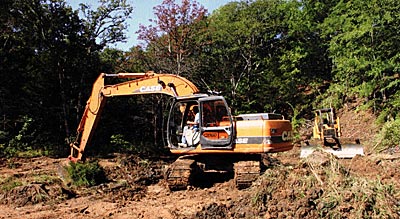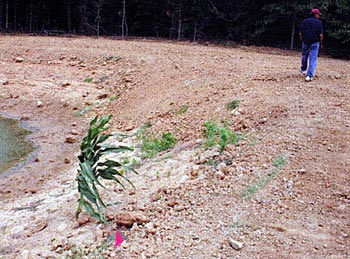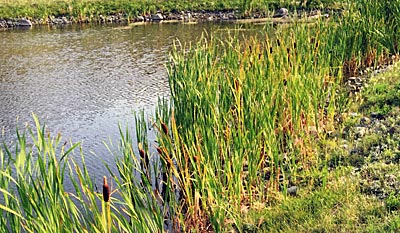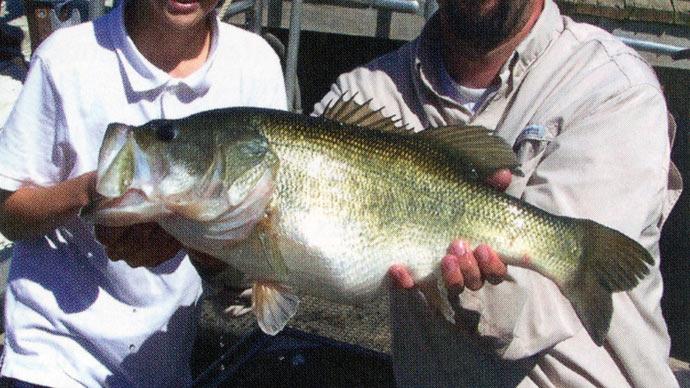
Years ago, a common recommendation a biologist might make was a winter drawdown. Why in the world do that, you might ask?
There are several reasons.
One reason is to expose rooted aquatic vegetation to winter's frigid temperatures. If a pond had massive volumes of annoying underwater salad, dropping the lake level would leave big mats of plants high and dry—and hopefully frozen by winter's end.
That actually could be a good idea, but it depends on the plant species a pondmeister is trying to target. Here's the rub, though. Some plants we like. Others, we don't. Some species might be susceptible to freezing, others aren't. A key part of the decision-making process hinges on a solid understanding of those plants and the consequences of pulling water off for two-or three-months during winter.
Coontail isn't rooted, so it will likely not be seriously affected by a winter drawdown. Odds are high that coontail has drifted into deeper parts of the pond and will be there next spring. American pondweed is a rooted plant, and with cold enough temperatures on exposed ground, you can seriously reduce its volume. But, it has already deposited seeds by the time winter shows up. Seeds will sprout next spring. Besides, we really like American pondweed. It's one of the good plants in your ecosystem. What about cattails? Great idea! Except their tubers are often several inches deep in the mud. If the dirt dries out far enough down, or your mud freezes a foot deep, cattails can be impacted. Quite a few ifs for cattails. Same with American lotus, except their tubers are much deeper than even cattails. Knowing the lifestyle of your noxious aquatic plants is important before choosing winter drawdown as an effective management tool.

Drawing water off a pond has lots of ifs when it comes to managing aquatic plants. Knowing your plants is important.
But there are other reasons, 'er consequences, of winter drawdown of a pond. When you pull a foot or two, or three, off your pond, will it fill back up next spring? I remember recommending winter drawdown to a northwest Texas rancher back in the late 80s. His eyes got wide, and he snarled, "Boy, pulling water out of my pond might be considered a hangin' offense, like cattle rustlin'." That part of the planet had just come out of a three-year drought. Even thinking about taking water out of a stock pond wasn't an option in his mind. Good point. Water is valuable in many parts of the country.
Quite a few times, I've been asked by a neighborhood association member about drawing down their neighborhood lake for maintenance. That's a normal practice for some lakes, especially where rainfall is plentiful. One lake, in North Carolina, is drawn down anytime a hurricane threatens the coast. They want to make room for more water and keep pressure off the spillway and gate system of the dam. Good idea. While that lake may only be down for a few weeks at a time, residents have time to spruce up their shoreline, make repairs on retaining walls and docks, and fix spots where wave action has eroded their waterfront.
What else happens when a pond or lake is drawn down, especially in winter? While the main purpose might be an attempt at plant management, fixing a shoreline, or deepening a shallow area, other things are happening.
Fish that live in shallow areas are driven from their cover. Sure, when the water temperature drops below their comfort level, they might move anyway, but when the water drops out of their home base, they have to go into deeper areas of the pond. Fish populations are concentrated, big fish eat small fish, and the population dynamics of your fishery will change, especially if the habitat in deeper water is limited.

Look at it this way. If your pond is two acres and you drop it three feet, you've likely removed half the water volume. You've also cut the surface area at least 30% in most normal ponds. Between the volume and surface area, you've effectively changed the entire environment, and the fishery will make an adjustment. That's probably a good thing. Big fish can gain significant weight as your pond gets rid of some fish you weren't likely to harvest anyway. Nature's way is to adjust to the available area, habitat, and opportunity. Fish numbers will go down, but the fishery makes a shift. When the pond fills back up, now there's new space, nature offers a new opportunity. Spawns are impressive, the food chain adjusts, and there are fewer predators. Winter drawdown for a fishery can be extremely helpful.
When down, peripheral pond soils get a chance to breathe. As that exposed ground dries, it contracts. Organic matter dries up, composts more quickly, and the soil gets a well-needed break. That's helpful.
What are the downsides to winter drawdown?
If the drawdown lasts too long, the fishery can be seriously affected—enough that restocking of key forage fish, especially bluegills, may need to occur. Terrestrial plants will quickly grow in exposed areas, leaving a thick mass of dense plants around the perimeter. Mowing and weed eating might become the new norm around a pond bottom.
Is winter drawdown a smart thing? It can be, depending on the mission and where you live. If there's a good reason, and a reasonable chance your pond will fill with spring rains, consider it. If you are doing it solely to deal with aquatic plants, think carefully. There are other tools in your pond management tool kit to deal with obnoxious plants.
You don't want to be that guy who gets accused of water rustlin', do you?
Reprinted with permission from Pond Boss Magazine



